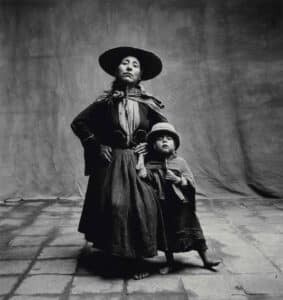Introduction:
Irving Penn, born in Plainfield, New Jersey, in 1917, transcended the realm of photography to become a luminary of 20th-century art. Renowned for dismantling the boundaries between commercial and fine-art photography, Penn’s legacy is a
Early Years and Evolution:
Penn’s journey into the visual arts began in the mid-1930s, studying painting and graphic design at the Pennsylvania Museum and School of Industrial Art. However, the turbulence of World War II led him to serve as an ambulance driver in Italy, temporarily diverting his path. In 1943, fate intervened when he joined Vogue magazine as a designer. Dissatisfied with the photographers employed, Penn transitioned into the role himself, capturing 163 Vogue covers and establishing himself as a
Fashion Revolution: Harlequin Dress and Vogue Covers:
Penn’s revolutionary approach to fashion photography was epitomized by his iconic Vogue covers. The ‘Harlequin Dress,’ featuring his wife Lisa Fonssagrives-Penn, exemplifies his emphasis on style over context. The classical symmetry and unadorned settings were revolutionary, sparking a paradigm shift in the genre. Penn’s Vogue covers, including the famous 1950 portrait of Jean Patchett, continue to fetch top prices at auctions, appealing to a broad audience beyond photography and fashion enthusiasts.
Portraits: The ‘Corner Portraits’ and Close-Ups:
Penn’s lens extended beyond fashion, capturing cultural luminaries such as Truman Capote, Georgia O’Keeffe, and Pablo Picasso. His ‘corner portraits,’ initiated in 1948, revealed the essence of his subjects through a distinct composition that became a hallmark of his portraiture. In the 1950s, he pioneered close-up celebrity shots, offering intimate glimpses into the souls of his
Still Life and Penn’s Passions:
In the 1960s, Penn ventured into still life, creating a captivating book of floral studies titled ‘Flowers.’ His penchant for capturing imperfections, as seen in ‘Gingko Leaves, New York, 1990,’ showcased his ability to infuse grandeur into unlikely subjects. The ‘Cigarettes’ series, featuring magnified images of cigarette butts, exhibited at MoMA, further exemplified Penn’s ability to transform the ordinary into the extraordinary.
Travel and Platinum Prints:
Penn’s extensive travels, documented with his Rolleiflex camera, resulted in captivating portraits of New Guinea tribesmen and indigenous Peruvians. His platinum prints, particularly exemplified in ‘Cuzco Children, 1948,’ showcased
a breathtaking texture, resembling watercolors. Penn’s exploration extended to nude studies, where he employed innovative techniques such as bleaching prints for a chiaroscuro effect.
Legacy and Whimsical Side:
Irving Penn continued to work until his passing in 2009 at the age of 92. His legacy is not just one of sophistication and compositional economy but also a testament to his whimsical side. Still-life combinations, such as ‘Theatre Accident, New York, 1947,’ revealed a playful yet artful approach to photography.
Conclusion:
Irving Penn’s enduring legacy is a tapestry woven with elegance, innovation, and an unwavering commitment to his craft. From revolutionizing fashion photography to capturing the souls of cultural icons, his ability to infuse artistry into diverse subjects has left an indelible mark on the world of photography. As we continue to explore the breadth of Penn’s work, his influence resonates, ensuring that his contributions to the art form are timeless.
This article is proudly presented by Motion Mounts Studio. All ideas expressed herein are original and copyrighted by Motion Mounts Studio. No part of this content may be reproduced without explicit permission. ©


